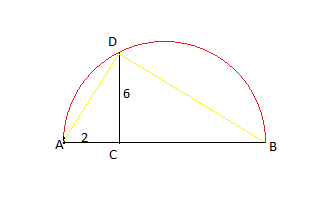
Let CB = x cm.
From triangle ACD, where angle ACD = 90'.
AD^2 = AC^2 + CD^2
= 2 ^2 + 6 ^2
=40. -----------------(P)
From triangle BCD, where angle BCD = 90'.
BD^2 = CB ^2 + CD ^2
= x ^2 + 6 ^2 ---------(Q)
From triangle ABD, where angle ADB = 90'.
AB^2 = AD ^2 + BD ^2
=> (2 + x)^2 = 40+ (x^2+ 36) //from eqn- P and Q.
=> 4 + 4x + x ^2= 76 + x^2
=> x = 72/4 = 18.
Diameter of cemi-circle = 2 + x = 2 + 18 = 20.
So, radius = 10 cm.
Hence, area of semi-circle = $\pi$(10 ^2 ) / 2.
= $50\pi$.
Ans- 2.